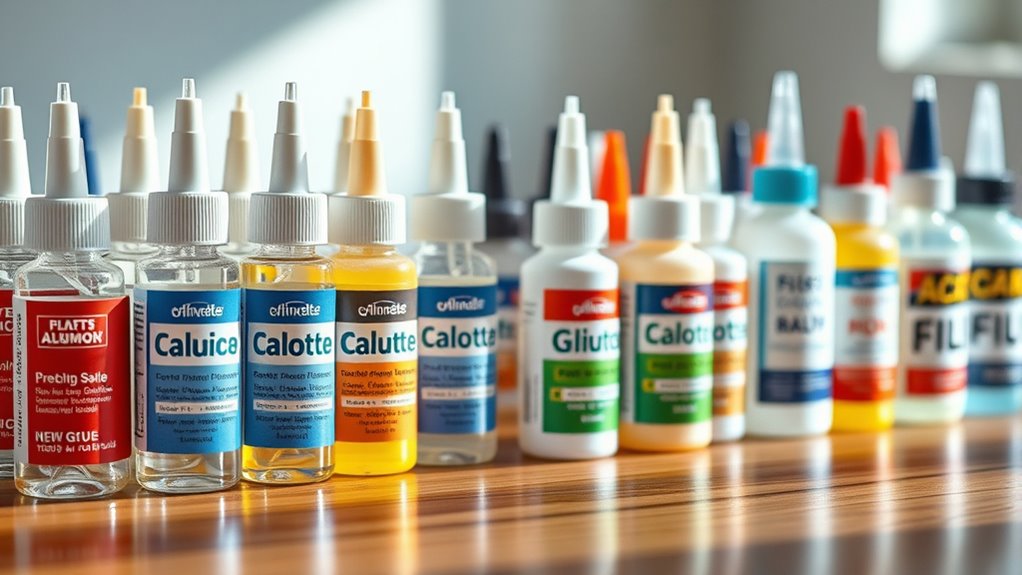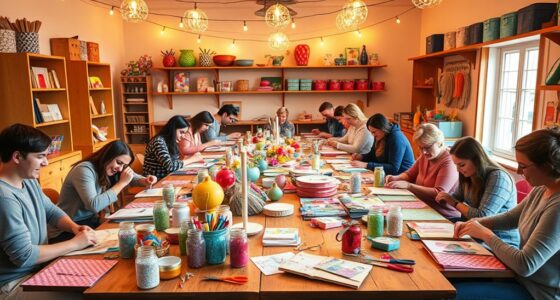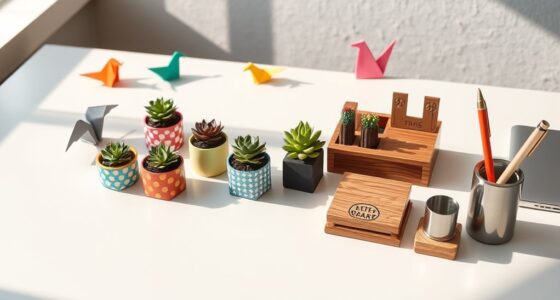Choosing the right craft glue depends on your project’s materials and needs. For paper, PVA glue works well, while fabric projects benefit from fabric or hot glue. For stronger bonds on wood, epoxy or wood glue are best. Consider factors like drying time, flexibility, and outdoor use. Using the appropriate glue will guarantee your project lasts. Keep exploring to discover detailed tips on choosing and applying the perfect adhesive for your craft needs.
Key Takeaways
- Match the glue type to your materials: paper, fabric, wood, plastic, or glass.
- Consider drying time and flexibility needed for your project’s durability.
- Choose strength and environmental resistance based on indoor or outdoor use.
- Use appropriate glue guns or liquid adhesives for precision and bonding strength.
- Follow safety instructions and application tips for optimal results and durability.
Types of Craft Glues and Their Uses
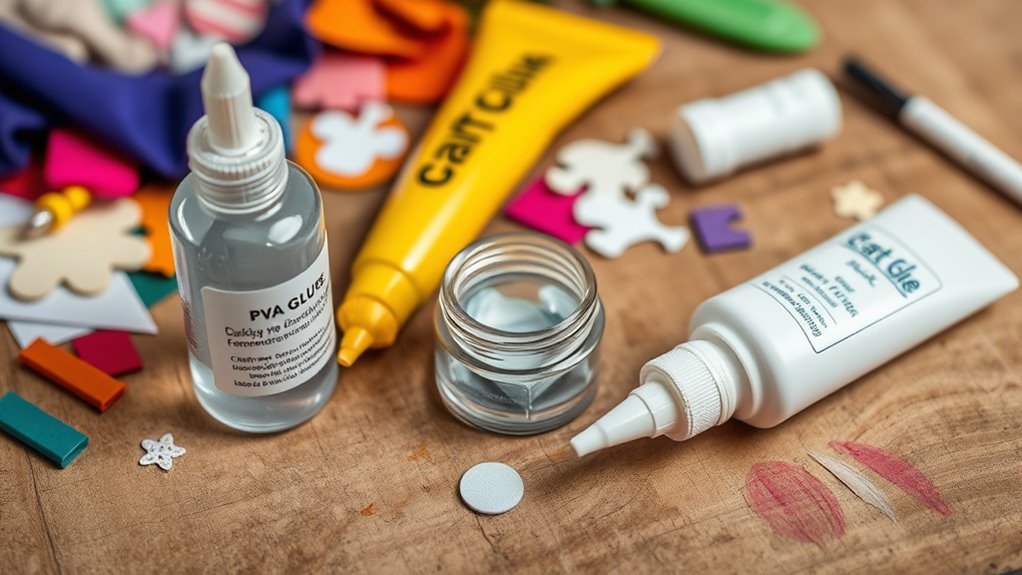
When choosing the right craft glue, understanding the different types and their specific uses is essential. For paper projects, PVA glue is your go-to; it dries clear and provides a strong bond without warping paper. It is also easy to clean up and widely available, making it a versatile choice for various paper crafts. Additionally, PVA glue can be used in wicks and other craft projects requiring a gentle, yet effective adhesive.
If you’re working with fabric, opt for fabric glue or hot glue, which offers flexibility and quick adhesion. Fabric glue is specially formulated to remain flexible after drying, which is crucial for wearable or textured textile projects, while hot glue provides immediate bonding for non-porous or heavy-duty fabrics. In both cases, selecting the appropriate adhesive ensures durability and a neat finish.
For fabric projects, choose fabric glue or hot glue for flexibility and quick sticking.
For ceramics and glass, epoxy glue creates a durable, waterproof bond, while super glue (cyanoacrylate) is perfect for quick fixes on small, non-porous surfaces. Epoxy glue often requires mixing two components but results in a very strong, lasting bond suitable for household repairs. Understanding the adhesive properties such as flexibility, waterproofing, and drying time are crucial factors to consider when selecting the appropriate glue for your project.
Woodcrafts benefit from wood glue, which penetrates and bonds fibers firmly. Applying wood glue ensures a secure and lasting connection, especially for furniture or structural projects. Additionally, material compatibility is an important aspect to evaluate to ensure the adhesive bonds effectively with your chosen materials. When selecting a wood glue, consider whether the project will be exposed to moisture or stress, as this can influence your choice.
Each type has unique properties suited for specific materials, so selecting the right glue ensures your project holds together well and looks professional. Understanding the different adhesive types and their best uses helps you craft with confidence and precision.
Factors to Consider When Selecting an Adhesive

Choosing the right adhesive depends on several key factors that can make or break your project’s success.
First, consider the materials you’re bonding; some glues work better with paper, while others excel with wood, fabric, or plastic. Incorporating sound vibrations into your selection can influence adhesion properties, especially for materials sensitive to vibrations. Next, think about the drying time—do you need a quick set or a longer window to adjust? Understanding adhesive chemistry can help you choose formulas tailored to your specific needs. Strength is also vital—will the bond need to withstand stress or weight? Additionally, think about the glue’s flexibility; some adhesives remain pliable, while others become rigid. Considering environmental conditions, such as exposure to water, heat, or sunlight, is also essential for long-lasting bonds. Safety is another factor—look for non-toxic options if you’re working with children or on projects in enclosed spaces. Finally, consider the anti-aging effects of certain adhesives, which can enhance durability over time.
Popular Types of Glue Guns and When to Use Them
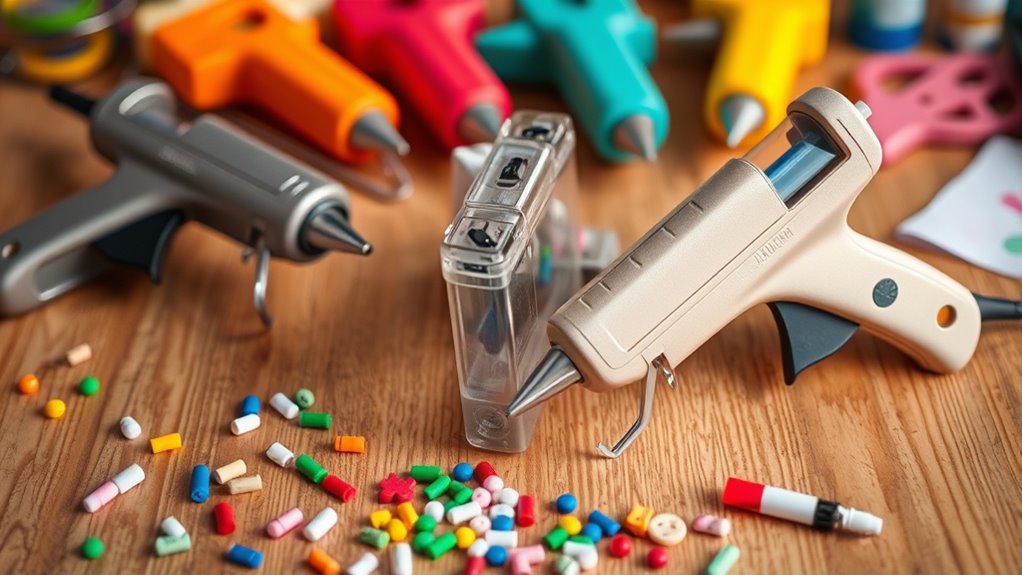
Selecting the right glue gun can markedly improve your crafting experience, especially since different projects demand specific features. For small, detailed work, choose a low-temperature glue gun; it offers precision without damaging delicate materials. For larger projects, a high-temperature gun provides stronger bonds and quicker melting. Cordless glue guns offer portability for on-the-go projects, while corded models ensure continuous power for extended use. Understanding adhesive properties can also help in choosing appropriate tools and materials for pet-related crafts. Additionally, being aware of the types of glue guns and their compatible accessories can enhance your crafting efficiency and results. Recognizing the safety features of different models is crucial to prevent accidents and ensure a safe crafting environment. Knowing about temperature controls can further assist in selecting a model that fits your specific needs and safety standards.
Liquid Adhesives: Features and Applications

Have you ever wondered how liquid adhesives can provide a seamless bond for various materials? These adhesives are versatile and easy to use, making them popular in many crafts. They typically come in bottles or tubes, allowing precise application. Liquid adhesives work well on paper, fabric, wood, and light plastic, forming strong, durable bonds. They dry relatively quickly, but drying time can vary depending on the material and thickness applied. Some are water-based, making cleanup simple with soap and water, while others are solvent-based, offering stronger adhesion but requiring careful handling. Use liquid adhesives when you need a precise, clean bond, especially for intricate projects or delicate materials. They’re ideal for scrapbooking, paper crafts, and light DIY repairs. Additionally, understanding the types of adhesives can help you select the best one for your specific project needs. Considering the performance features such as drying time and bond strength can help ensure your project’s success. For optimal results, choosing an adhesive that aligns with your material compatibility is essential to prevent damage or weak bonds. Furthermore, selecting the right adhesive can also contribute to long-term durability, ensuring your project remains intact over time.
Specialty Glues for Unique Crafting Needs
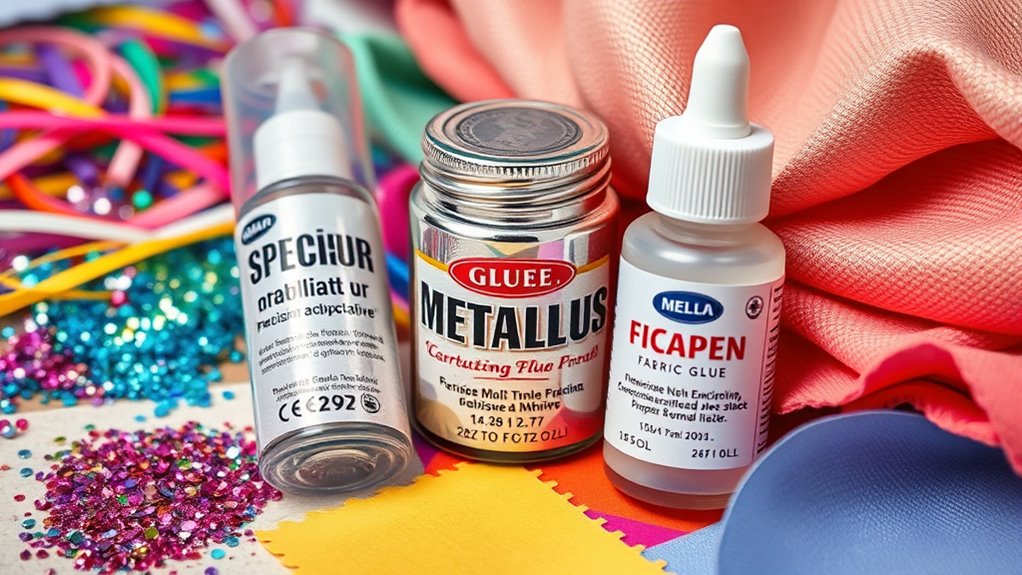
When your project requires bonding unusual or delicate materials, specialty glues can provide the perfect solution. These adhesives are designed for specific materials, such as fabric, glass, metal, or even ceramics, where standard glues might fail. Using the correct type of glue ensures a strong and lasting bond without damaging the surface.
For example, you might use a hot glue gun for quick, strong bonds on fabric or felt, or a two-part epoxy for metal and glass pieces that need a durable connection. Some specialty glues are formulated for waterproof or heat-resistant applications, ideal for outdoor crafts or kitchen projects. Understanding the filtration systems of adhesives can help you select the most effective glue for your specific project needs.
Others are designed for delicate surfaces, like decoupage or jewelry making, where precision and gentle bonding matter most. Choosing the right specialty glue ensures your project holds together securely without damaging sensitive or unusual materials. Additionally, understanding the types of self watering plant pots can help you select adhesives suitable for outdoor or moisture-prone environments. Moreover, selecting an adhesive with appropriate chemical resistance can extend the durability of outdoor crafts exposed to weather elements. Staying informed about the trustworthiness of AI models can also inspire confidence in selecting reliable adhesives from reputable brands.
Tips for Applying and Handling Craft Glues
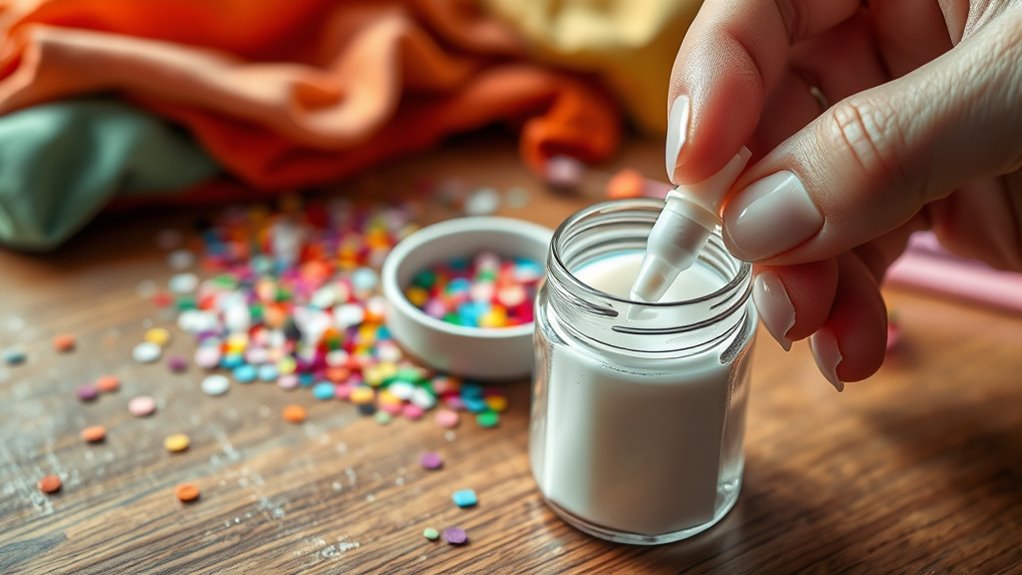
To achieve the best results when working with craft glues, it’s vital to apply and handle them carefully. First, always read the instructions to understand the glue’s drying time and best application method. Second, use a small amount—less is more—to prevent messes and guarantee a clean finish. Third, apply the glue evenly to avoid weak spots and secure a strong bond. Fourth, work in a well-ventilated area to keep fumes at bay and stay comfortable. Remember, patience is key—wait for the glue to set properly before handling or adding additional layers. Additionally, being aware of the company values and proper practices can help ensure a safe and effective crafting experience. Paying attention to catering and delivery trends can also inspire innovative ideas for your projects.
Safety Tips and Maintenance for Your Adhesive Supplies
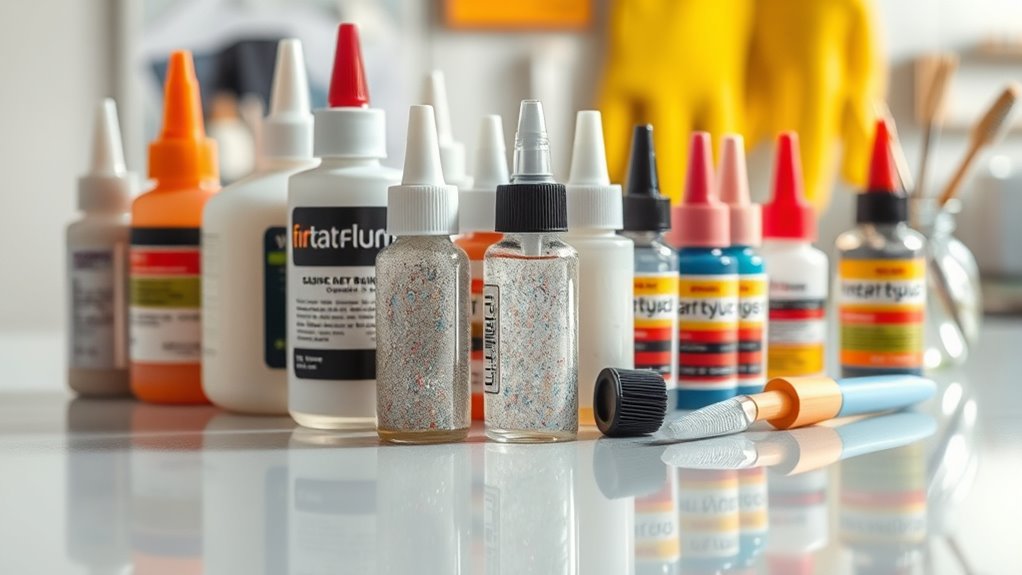
Handling craft glues properly isn’t just about application; it also involves prioritizing safety and maintaining your supplies. Always work in a well-ventilated area to avoid inhaling fumes, and keep caps tightly sealed after use to prevent spills and drying out.
Store your adhesives in a cool, dry place away from children and pets. Regularly check for expired or thickened glue, and dispose of it safely. Clean your tools promptly to prevent buildup and ensure smooth application next time.
Wear protective gear, like gloves or masks, if recommended by the manufacturer. If a spill occurs, clean it immediately with appropriate materials.
Frequently Asked Questions
How Long Does Each Type of Glue Take to Fully Cure?
You’re wondering how long different glues take to fully cure. Typically, craft glues like PVA glue dry within 30 minutes to an hour but may need 24 hours to cure completely for maximum strength.
Hot glue sets in about a minute but takes 24 hours to fully cure.
Two-part epoxies cure in 5 to 15 minutes but reach full strength in 24 hours.
Always check the manufacturer’s instructions for precise curing times.
Are There Eco-Friendly or Non-Toxic Craft Glues Available?
You’re asking if eco-friendly or non-toxic craft glues are available, and the answer is a resounding yes. Many brands now prioritize safety and sustainability, offering glues made from natural ingredients that are free of harmful chemicals.
These adhesives work just as well for your projects and are gentle on the environment. It’s a win-win situation, proving you can stick to your values without sacrificing quality.
Can I Remove or Reposition Glue After It Dries?
Once glue dries, removing or repositioning can be tricky. If you used a temporary or repositionable glue, you might be able to gently peel or slide the material before it fully sets.
For permanent glues, try applying heat with a hairdryer or use a solvent like rubbing alcohol or acetone carefully to loosen the bond. Always test a small area first to avoid damaging your craft.
Which Adhesives Are Best for Outdoor or Weather-Resistant Crafts?
For outdoor or weather-resistant crafts, you want adhesives that stand up to the elements. You should choose waterproof glues like epoxy, polyurethane, or exterior-grade super glues.
These options bond strongly to various surfaces and resist moisture, temperature changes, and UV exposure. Make sure to follow the manufacturer’s instructions for proper application and curing times to guarantee your project stays durable and weather-resistant over time.
How Do I Troubleshoot Glue Failure or Weak Adhesion?
Imagine your outdoor project’s glue fails after a rainstorm. To troubleshoot weak adhesion, first check if you used the right glue for the material and conditions.
For example, if you used standard glue on waterproof surfaces, it mightn’t bond well. Confirm surfaces are clean, dry, and free of dust or oils.
Sometimes, applying a primer or choosing a weather-resistant adhesive can prevent future failures.
Conclusion
Choosing the right craft glue is like finding the perfect partner—trust your instincts, consider your project’s needs, and you’ll create something truly lasting. With the right adhesive, your ideas stick as firmly as your passion. Remember, the right glue isn’t just about holding things together; it’s about turning your creativity into a masterpiece that endures. So, pick wisely and watch your craft come to life—because the bond you choose makes all the difference.
